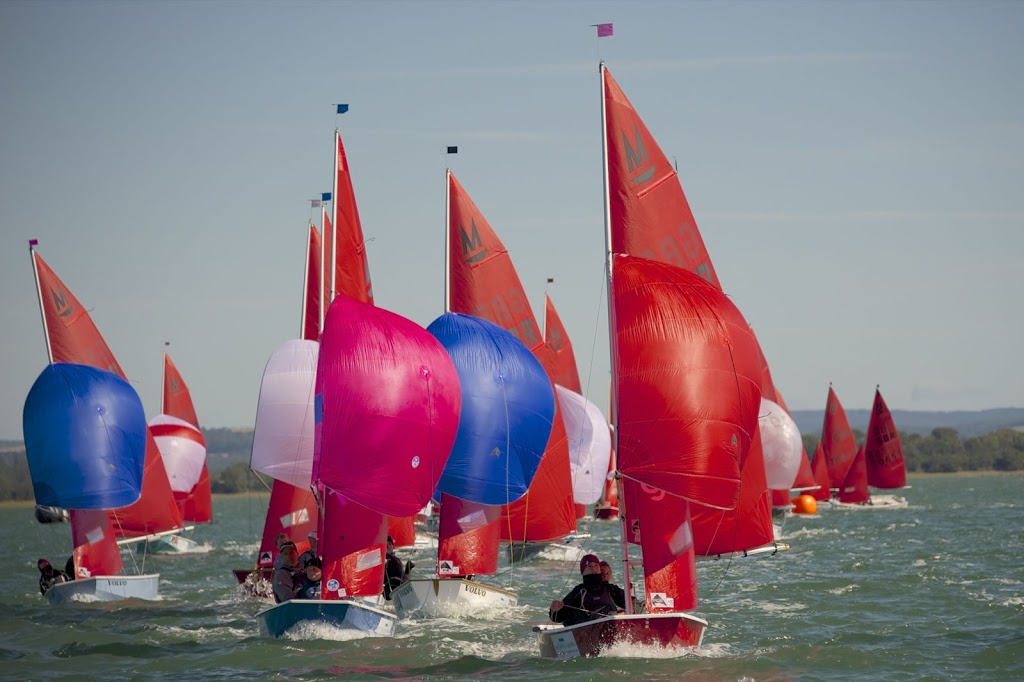A West Eleven Mark 1 - photos from a 2023 advert
(editors note: this history of the West Eleven dinghy was posted by Mike Waddington (Razor1955) on the Yachting and Boating forum and I've taken the liberty of reproducing it here. Another user posted that, on the Mark 1 "...the spars, gunwales and thwarts are all wooden..." . I understand the West Eleven dinghy dates from 1969 (I'm pretty sure there was one at the 1969 Boat Show), or the 1970s, Anyway, Mike Waddington takes up the story:)
The West Eleven was definitely inspired by the Mirror dinghy but at the time they were in production there was no alternative GRP version - and GRP was the "in thing"
The dinghy was designed by my cousin Geoffrey R Sutton who at the time was Managing Director and owner of Weston Electric Units Ltd., Station Road, Foulridge, Colne, Lancashire, a company which had been formed by his father Richard. My own father was Works Manager there until his death in 1986. The company were high-precision, machinist sub-contractors to the aircraft industry, making components for British Aerospace and Rolls Royce Aero Engines, for both military and commercial aircraft. Geoffrey was also a keen sailor and had a holiday property on Windermere where Shepherds had built a small sailing day cruiser for him.
He had the idea of building a GRP dinghy to much the same formula as the Mirror, but slightly longer (editors note: about 5"), as has been mentioned and with some compound curvature to the hull section which was not possible with ply construction. They built a plug from which moulds were made, at a time when the aircraft business was in the doldrums, as a means of maintaining employment for the workforce and income for the company.
The dinghies were initially built in a tiny factory unit situated at Catfold Farm, Foulridge, approximately 500 yards from the main engineering factory, and the premises were inspected and certified by Lloyds I seem to recall.
As soon as the dinghy hit the market there was indeed a legal challenge raised by Jack Holt and Barry Bucknell, the joint designers of the Mirror. When it went to court it was noted that the West bore a striking resemblance to the Mirror, but my cousin successfully argued:
1. The the lines of the West Eleven could not be accurately reproduced in sheet plywood and that the finished dinghy was dimensionally different from the Mirror.
2. That the patent referred to by Barry Bucknell was specific to the stitch-tape-glue construction and had no application or bearing on the construction of the West Eleven.
It was therefore ruled that there was no direct infringement of the Mirror design and the case was dismissed, but a concession was agreed that the inner moulding would be altered to give greater distinction between the Mirror and the West Eleven, Thus was born the West Eleven Mark 2, where the foredeck was replaced by an open cockpit with a cross beam carrying a mast step. The hull outer moulding remained the same however.
West Eleven Mark 2 - photos from a 2023 advert
Around this time, the aircraft industry was recovering from it's troubles and as business returned to normal production was handed over to Shepherds who continued to make West dinghies for a time. All the Weston produced boats were in the familiar white hull/blue interior. The Shepherds boats may have different coloured gelcoat and have a glassfibre thwart to stiffen the daggerboard box, whereas the original Weston boats have a plywood thwart. In both cases the GRP mast step/thwart has two positions, the one towards the box allowing the boat to sail without the jib. They also feature an alloy mast as standard.
There was a small flotilla of them at the Ullswater Sailing School for several years but I have no idea if any of these survive or if the moulds still exist. In any event, true GRP Mirror dinghies arrived on the scene which made the West Eleven a little redundant.
The original manufacturers continued for many years as a hugely successful precision engineering business, and after the passing of Geoffrey Sutton it continued in the family and run by his sons, until they sold the company to Senior Engineering around 10 years ago, where the factory was moved to Earby, West Yorkshire and is still in operation.
My personal West Eleven connection is that I purchased a Mark 1 around 1980 followed by another - and then another. Quite by chance I ended up with two dinghies that had consecutive sail numbers (1361/1362 - or thereabouts) and there was the Mark 1 and two Mark 2s. I sold all the dinghies when moving house in the late 1990s to a now-defunct Nationwide Boat Sales near Chesterfield - so they are still probably out there somewhere.
I hope this information has been useful to owners and to those building a history of the dinghy. They are very handy boats, probably a little heavier than a GRP Mirror but in the right hands a little faster compared with a Mirror of the same era.
As a further note, I should say that although many West dinghies may be using Mirror sails, the West Eleven originally had its own suit of Jeckells sails which had a slightly different area than the Mirror. Unfortunately I don't remember the fine details.




